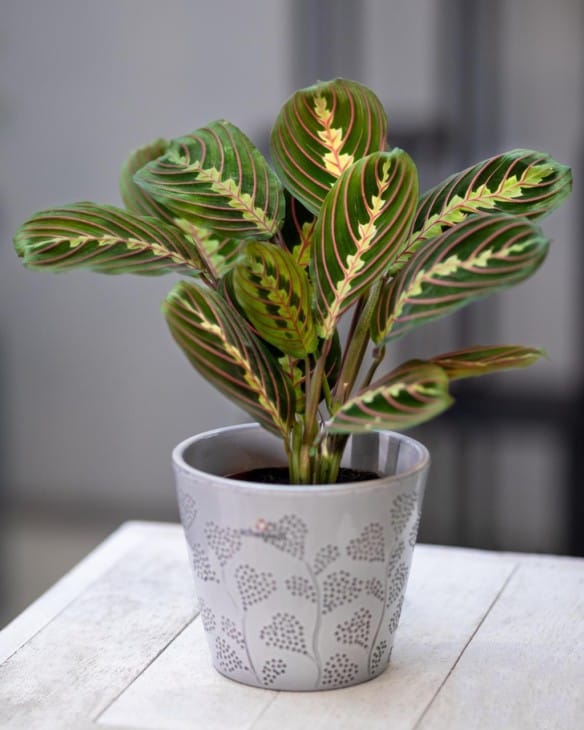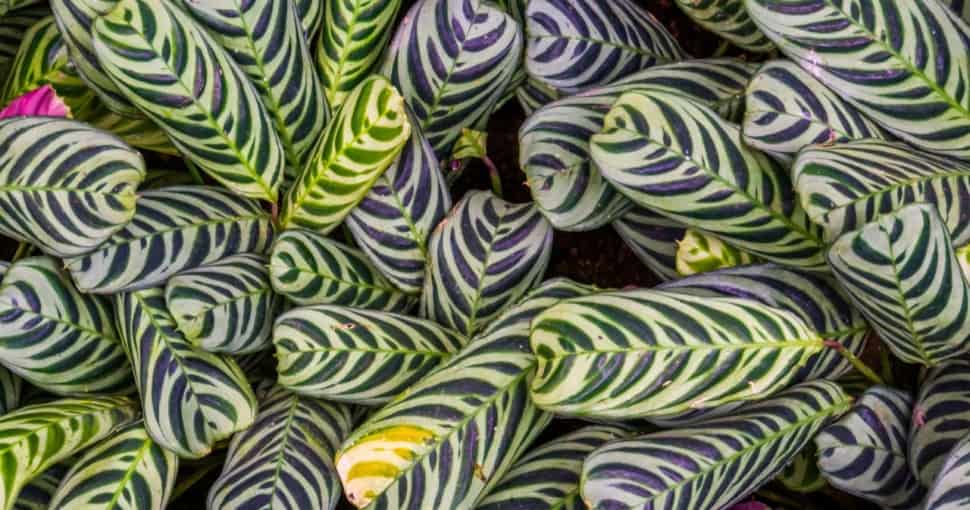Prayer plants, Maranta leuconeura, are evergreen perennials found in tropical places such as Brazil. While the plants do produce white or purple flowers, they are known for their striking leaves with their pattered greens and deep red veins. But there is more to them than their good looks.
Contents
- 1. Prayer Plants Don’t Just Sit There
- 2. Prayer Plants Are The Perfect Thank You
- 3. Prayer Plants Don’t Need Much Attention
- 4. Prayer Plants Don’t Need Much Space
- 5. Prayer Plants Help Clean The Air
- 6. Prayer Plants Can Help Reduce Noise Pollution
- 7. Prayer Plants Lift Mood
- 8. Prayer Plants Help Lower Stress
- 9. Prayer Plants Help Teach Empathy
- 10. Prayer Plants Are Not Toxic
- 11. Prayer Plants Are Pet Safe
Prayer plant benefits include being the perfect thank you gift. This is because the plants symbolize gratitude. Other benefits include being fun to watch as they move, as well as making the air cleaner in your living and workspaces, taking up little space, and being easy to maintain.
Prayer plants can live outdoors in tropical climates and make an eye-catching ground cover. However, for most of North America and Europe, the evergreen perennial exists as a popular houseplant. There are between forty to fifty varieties of prayer plants, the most common being Maranta.
Related: 6 Plants That Look Like Prayer Plants
1. Prayer Plants Don’t Just Sit There
One of the biggest benefits to prayer plants is that they move. Each night their leaves will curl up as if they’re taking part in evening prayers. Thus, they create gentle entertainment, much less hectic than a cat’s zoomies.
However, unlike the Venus flytrap, they don’t do it to eat. The movement of the pray plant’s leaves is due to turgor pressure created by swelling and shrinking that occurs with the plant’s natural circadian rhythm. Some suspect it helps the plant capture water when living outdoors.
2. Prayer Plants Are The Perfect Thank You
Because the prayer plant resembles putting its hands together (leaves) in an act of worship, it has long symbolized gratitude. Thus, they are the perfect way to express your gratefulness when telling another person “thank you.”
People have also found their meaning of gratitude a comfort during huge times of stress. Thus, in 2021 their popularity shot up, as those locked down tried to focus on the simple things that keep us going in the everyday.

3. Prayer Plants Don’t Need Much Attention
Prayer plants are pretty easy to keep alive and don’t require a ton of extra work. Most of it is set up, just making sure you have the right amount of light for your particular variety. Prayer plants enjoy their soil damp but not waterlogged.
Payer plats do appreciate humidity. But this is easily achieved by keeping them on a wet pebble tray. Or, if you enjoy having a greenhouse, they’ll be happy there.
4. Prayer Plants Don’t Need Much Space
Prayer plants enjoy shallow pots because their roots system doesn’t go deep. Most varieties don’t get very big, either. Typical height is 10-12 inches (25.4 – 30.5 cm) and when fully fanned out, spread 15-18 inches (38 – 45.7 cm). Thus, they make them a delightful statement piece, even in snug living or workspaces.
5. Prayer Plants Help Clean The Air
Air purifiers are on the rise as people become increasingly aware of the unseen pollution lurking in the air. Part of this increase in concern has been due to the EPA reporting that pollutants can be 2-5 times greater indoors than outdoors.
However, air purifiers are not the eco-friendliest solution to cleaning indoor air. They require electricity to work and are often made out of nonrenewable resources. However, plants are excellent natural air purifiers. NASA has even confirmed this with experiments that were performed in space.
6. Prayer Plants Can Help Reduce Noise Pollution
Ever notice how when you visit a plant lover, or in a plant-filled public space, the air around you seems softer, quieter, more at peace? That’s not just because of the aesthetic ambiance plants bring. Plants, depending on the quantity, plants can reduce noise in a space as much as 5-10 decibels.
With their beautiful broad leaves, prayer plants can help reduce noise pollution in your living and workspaces. This is because plants don’t just absorb noise but also deflect and refract, cutting down on the amplification and echo inside a space.
The more plants you own, the more you benefit from their noise reduction. Plant stands and hanging baskets are space-saving ways to increase a collection.
7. Prayer Plants Lift Mood
Prayer plants don’t just lift their leaves but can boost mood, too. One of the reasons for this is a friendly bacteria called Mycobacterium vaccae. This microscopic organism has a positive impact on the parts of the brain that make serotonin.
Serotonin is a feel-good chemical that plays a crucial part in our bodies. It aids in the communication between the brain and the nervous system. Proper amounts of serotonin are reflected in stable moods, a sense of well-being, often reported as “happiness.”
8. Prayer Plants Help Lower Stress
Houseplants, such as prayer plants, create a calming presence that reduces stress and anxiety. This is because the sympathetic nervous system calms as we interact with plants, reducing our diastolic blood pressure, consequently producing an overall feeling of being soothed.
The lowering of stress and anxiety has been shown to occur in various spaces, including homes, offices, hospitals, and classrooms. Additionally, the lowering of stress and anxiety makes it easier for people to focus and thus become more productive. However, this benefit was not achieved with fake plants.
9. Prayer Plants Help Teach Empathy
Caring for animals and plants, such as prayer plants, has been used to help teach children empathy. This is due to fostering “perspective-taking,” which is the cognitive side of empathy where caring is the emotional.
While it is good to have feelings, which it comes to ecological preservation, the cognitive must be engaged, not just the emotional side of being “cute.” There needs to be the ability to understand why something matters even if we don’t live there or raise that plant or animal.
10. Prayer Plants Are Not Toxic
Prayer plants are not listed as toxic for people. This is a big benefit for homes and spaces that children are known to occupy.
However, this does not mean the consumption of prayer plants should be encouraged. Should there be a concern that a child has eaten part of a plant, do contact your doctor or poison control.
11. Prayer Plants Are Pet Safe
Prayer plants are not listed as toxic for pets. According to the ASPCA, they are non-toxic to dogs, cats, and horses. This is an advantage to lovers of four-legged friends, as these animals do have a habit of tasting their surroundings.
Should, however, your pet consume part of a prayer plant and is showing concerning signs, do contact your vet.







